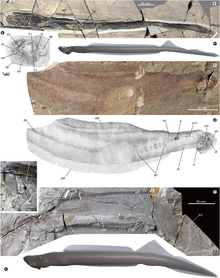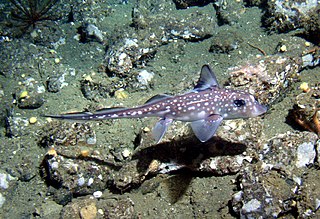
Chimaeras are cartilaginous fish in the order Chimaeriformes, known informally as ghost sharks, rat fish, spookfish, or rabbit fish; the last three names are not to be confused with rattails, Opisthoproctidae, or Siganidae, respectively.

Pterygotus is a genus of giant predatory eurypterid, a group of extinct aquatic arthropods. Fossils of Pterygotus have been discovered in deposits ranging in age from Middle Silurian to Late Devonian, and have been referred to several different species. Fossils have been recovered from four continents; Australia, Europe, North America and South America, which indicates that Pterygotus might have had a nearly cosmopolitan (worldwide) distribution. The type species, P. anglicus, was described by Swiss naturalist Louis Agassiz in 1839, who gave it the name Pterygotus, meaning "winged one". Agassiz mistakenly believed the remains were of a giant fish; he would only realize the mistake five years later in 1844.

Baru, sometimes referred to as the cleaver-headed crocodile, is an extinct genus of Australian mekosuchine crocodilian. Its fossils have been found from various Late Oligocene and Miocene localities from across the Northern Territory and Queensland, indicating that Baru was a common genus during the late Paleogene and early Neogene. Three species are recognized, B. darrowi, B. iylwenpeny, and B. wickeni.
Liopleurodon is an extinct genus of carnivorous pliosaurid pliosaurs that lived from the Callovian stage of the Middle Jurassic to the Kimmeridgian stage of the Late Jurassic period. The type species is L. ferox, which is probably the only valid species. Some studies also include the second species L. pachydeirus, but this latter is considered as a probable junior synonym of L. ferox due to its lack of viable diagnosis. As the holotype specimen of L. ferox consists of a single tooth preserving questionable distinctive features, recent studies therefore recommend the necessary identification of a neotype in order to preserve the validity of the genus. Numerous fossil specimens attributed to Liopleurodon, even including numerous skeletons, have been discovered in Europe, Russia, and Mexico. Other additional species were even proposed, but these are currently seen as coming from other pliosaurid genera.

Mekosuchus is a genus of extinct Australasian mekosuchine crocodilian. Species of Mekosuchus were generally small-sized, terrestrial animals with short, blunt-snouted heads and strong limbs. Four species are currently recognized, M. inexpectatus, M. whitehunterensis, M. sanderi and M. kalpokasi, all known primarily from fragmentary remains.

Quinkana is an extinct genus of mekosuchine crocodylians that lived in Australia from about 25 million to about 10,000 years ago, with the majority of fossils having been found in Queensland. Four species are currently recognized, all of which have been named between 1981 and 1997. The two best understood species are Q. fortirostrum, the type species, and Q. timara, a more gracile form from the Miocene. The other two species, Q. babarra and Q. meboldi, from the Pliocene and Oligocene respectively, are only known from a few poorly preserved bone fragments. The name Quinkana comes from the "Quinkans", a legendary folk spirit from Gugu-Yalanji mythology.

Rhizodus is an extinct genus of basal, finned tetrapodomorphs. It belonged to Rhizodontida, one of the earliest-diverging tetrapodomorph clades. Two valid species have been described, both of which lived during the Early Carboniferous epoch. The type species R. hibberti is known from the Viséan stage of the United Kingdom, whereas the species R. serpukhovensis is from the Serpukhovian of Russia. Some fossils referred to the genus Rhizodus have also been found in North America.

Marine vertebrates are vertebrates that live in marine environments. These are the marine fish and the marine tetrapods. Vertebrates are a subphylum of chordates that have a vertebral column (backbone). The vertebral column provides the central support structure for an internal skeleton. The internal skeleton gives shape, support, and protection to the body and can provide a means of anchoring fins or limbs to the body. The vertebral column also serves to house and protect the spinal cord that lies within the column.

Volia is an extinct monospecific genus of mekosuchine crocodylian closely related to Mekosuchus and Trilophosuchus. Volia is known from a collection of largely fragmentary remains including skull bones and limbs recovered from the Voli Voli and Wainibuku Caves on Viti Levu (Fiji), with similar remains having been found on Naigani. It was around 2–3 metres (7–10 ft) long, making it the largest predatory animal on the island and subsequently most likely the apex predator of the Pleistocene ecosystems of Fiji. It may have fed on giant iguanas, flightless birds or even fish. Like its closest relatives, it may have been more terrestrial than today's crocodiles.

Hybodontiformes, commonly called hybodonts, are an extinct group of shark-like cartilaginous fish (chondrichthyans) which existed from the late Devonian to the Late Cretaceous. Hybodonts share a close common ancestry with modern sharks and rays (Neoselachii) as part of the clade Euselachii. They are distinguished from other chondrichthyans by their distinctive fin spines and cephalic spines present on the heads of males. An ecologically diverse group, they were abundant in marine and freshwater environments during the late Paleozoic and early Mesozoic, but were rare in open marine environments by the end of the Jurassic, having been largely replaced by modern sharks, though they were still common in freshwater and marginal marine habitats. They survived until the end of the Cretaceous, before going extinct.
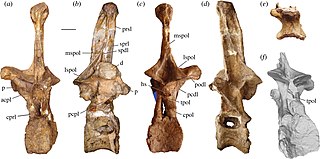
Amphicoelias is a genus of herbivorous sauropod dinosaur that lived approximately 150 million years ago during the Tithonian of what is now Colorado, United States. Amphicoelias was moderately sized at about 18 metres (59 ft) in length and 15 metric tons in body mass, shorter than its close relative Diplodocus. Its hindlimbs were very long and thin, and its forelimbs were proportionally longer than in relatives.

Lampreys are a group of jawless fish comprising the order Petromyzontiformes. The adult lamprey is characterized by a toothed, funnel-like sucking mouth. The common name "lamprey" is probably derived from Latin lampetra, which may mean "stone licker", though the etymology is uncertain. Lamprey is sometimes seen for the plural form.
Dinnebitodon is an extinct genus of tritylodontid mammaliamorphs from the Early Jurassic. It has only been found in the Kayenta Formation in northeastern Arizona. It closely resembles the related genus Kayentatherium from the same formation. It is set apart by differences in the dentition, while resembling in most other respects.
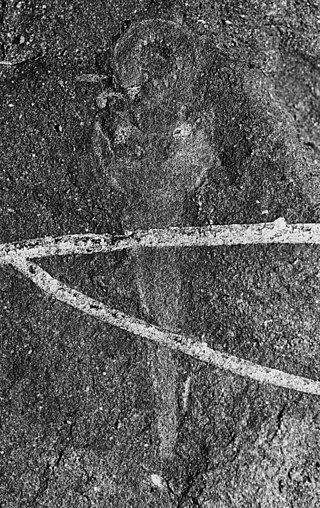
Priscomyzon riniensis is an extinct lamprey that lived some 360 million years ago during the Famennian in a marine or estuarine environment in South Africa. This small agnathan is anatomically similar to the Mazon Creek lampreys, but is some 35 million years older. Its key developments included the first known large oral disc, circumoral teeth and a branchial basket.
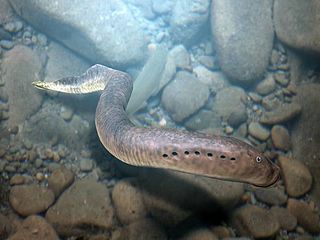
Mesomyzon mengae is an extinct lamprey from freshwater strata of the Early Cretaceous-aged Yixian Formation, in China.

Astorgosuchus is an extinct monospecific genus of crocodilian, closely related to true crocodiles, that lived in Pakistan during the late Oligocene period. This crocodile may have reached lengths of up to 7–8 m (23–26 ft) and is known to have preyed on many of the large mammals found in its environment. Bite marks of a large crocodile have been found on the bones of juvenile Paraceratherium, however if these were left by Astorgosuchus cannot be said with certainty. The genus contains a single species, Astorgosuchus bugtiensis, which was originally named as a species of Crocodylus in 1908 and was moved to its own genus in 2019.

Indosinosuchus is a genus of teleosaurid neosuchian that lived during the Late Jurassic or Early Cretaceous in what is now Thailand. It contains two species, the type species I. potamosiamensis and I. kalasinensis, both recovered from the lower Phu Kradung Formation. It is unique among teleosauroids as it is the only named genus known from a freshwater environment, while most other members of the group are marine. Indosinosuchus is placed in the family Teleosauridae, but has a relatively robust skull that bears resemblance to members of the Machimosauridae. Biomechanical analysis of its mandible and teeth suggest that it would have had a substantial bite force comparable to animals like Lemmysuchus. The two Indosinosuchus species however differ in the speed at which they could open and close their jaws, impacting their respective ecology and possibly explaining how they coexisted in the same environment. All known specimens of this genus were recovered from a single locality, which has been interpreted as a mass death site, possibly caused by a drought or flash flood. The precise age of Indosinosuchus is unclear, as the vertebrate fossils of the Phu Kradung Formation support a Late Jurassic age, while palynological data suggests an Early Cretaceous (Berriasian) age.
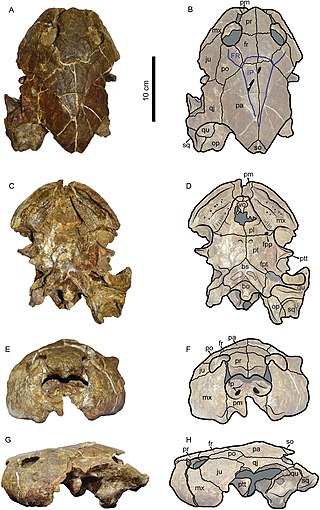
Caninemys is an extinct genus of large freshwater side-necked turtle, belonging to the family Podocnemididae. Its fossils have been found in Brazil and Colombia, in rocks dating back from the middle to late Miocene.

Ultrastenos is an extinct genus of Australian mekosuchine crocodilian that lived during the Late Oligocene in northwestern Queensland, Australia. Following its discovery, it was speculated that Ultrastenos was a slender-snouted animal similar to modern gharials or freshwater crocodiles due to the seemingly abruptly narrowing mandible. However, a later study found that this was a missinterpretation of the fossil specimen and that Ultrastenos instead had a more generalized lower jaw. The same publication also provided evidence that the fossils of Ultrastenos belonged to the same animal previously named "Baru" huberi, adding further evidence to the idea that the animal was short snouted, contrary to the initial hypothesis. Given that "Baru" huberi was named first, the type species of Ultrastenos changed from U. willisi to U. huberi in accordance with the rules of the ICZN. Ultrastenos was a small mekosuchine, measuring upwards of 1.5 m long.
Caeruleum is an extinct genus of lamprey from the Lower Cretaceous Jiufotang Formation of China. The genus contains two species, C. miraculum and C. gracilis, known from various specimens including complete and partial bodies.
